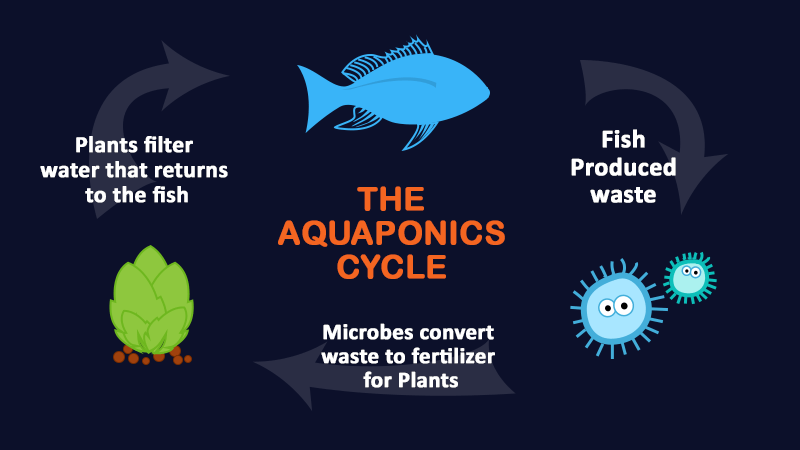What is Aquaponics?
Are you wondering “what is aquaponics?” The most simple definition is that it is the marriage of aquaculture (raising fish) and hydroponics (the soil-less growing of plants) that grows fish and plants together in one integrated system. The fish waste provides an organic food source for the growing plants and the plants provide a natural filter for the water the fish live in. The third participants are the microbes (nitrifying bacteria) and composting red worms that thrive in the growing media. They do the job of converting the ammonia from the fish waste first into nitrites, then into nitrates and the solids into vermicompost that that are food for the plants.
In combining both systems aquaponics capitalizes on the benefits and eliminates the drawbacks of each.
History of Aquaponics
- Long before the term “aquaponics” was coined in the 1970s the Aztec Indians raised plants on rafts on the surface of a lake in approximately 1,000 A.D.
- In modern times aquaponics emerged from the aquaculture industry as fish farmers were exploring methods of raising fish while trying to decrease their dependence on the land, water and other resources.
- Traditionally fish were raised in large ponds, or in netted pens off ocean coastlines, but in the past 35 years much progress has been made in recirculating aquaculture systems (RAS).
- The advantage of RAS is that fish can be stocked much more densely: up to of a pound of fish per gallon of water, thus using only a fraction of the water and space to grow the same amount of fish as pond or netting based systems.
- The disadvantage is the large amount of waste water that quickly accumulates.
- In the 1970s research on using plants as a natural filter began, most notably by Dr. James Rakocy at the University of the Virgin Islands.
- The first large scale commercial aquaponics facility, Bioshelters in Amherst, MA, was established in the mid-1980s, and it is still in operation today.
- Home based aquaponics owes its origin in the early 1990s to Tom and Paula Speraneo of S&S Aquafarms in West Plains, MO. The Speraneo’s diligently refined a media bed growing technique that was more appropriate for smaller systems, and wrote a how-to manual that became a spring board for many home based systems build through-out the world.
- Meanwhile, on the other side of the world in Australia interest in home aquaponics was taking off because aquaponics is a way to solve the drought and poor soil conditions that the Australians have to contend with. Joel Malcolm led the movement by starting a popular forum (Backyard Aquaponics) and creating and selling aquaponic systems designed specifically for homeowners. He was joined by Murray Hallam of Practical Aquaponics, who also runs a forum and is best known for his series of entertaining DVDs on home aquaponics.
- In January, 2010 the Aquaponic Gardening Community was formed, and it has since become the largest online gathering place for aquapons in North America.
- In September, 2011, the book Aquaponic Gardening by Sylvia Bernstein was introduced at the first annual Aquaponics Association Conference in Orlando, Florida. It was the first time that a complete guide to designing, building, starting and maintaining a media-based aquaponics system had been available. Within a month the book was the best selling gardening book on Amazon.com and within the first year the book was printed four times and sold over 30,000 copies.
- At that same conference the Aquaponics Association was officially created with Gina Cavaliero of Green Acre Aquaponics and Sylvia Bernstein of The Aquaponic Source as the founders and inaugural Chair and Vice Chair. The Association’s mission is to promote aquaponics, and to continue holding annual conferences so aquaponics practitioners from around the world can gather once a year to exchange ideas and learn from each other.
- With the Aquaponics Association increasingly focused on commercial farming, in August of 2014 the first Aquaponics Fest was held in Longmont, CO for home and school aquaponic gardeners.
.
Source: The Aquaponic Source, 2017 (https://www.theaquaponicsource.com/what-is-aquaponics/)
Tags: aquaponics cycle, aquaponicsgogreen

